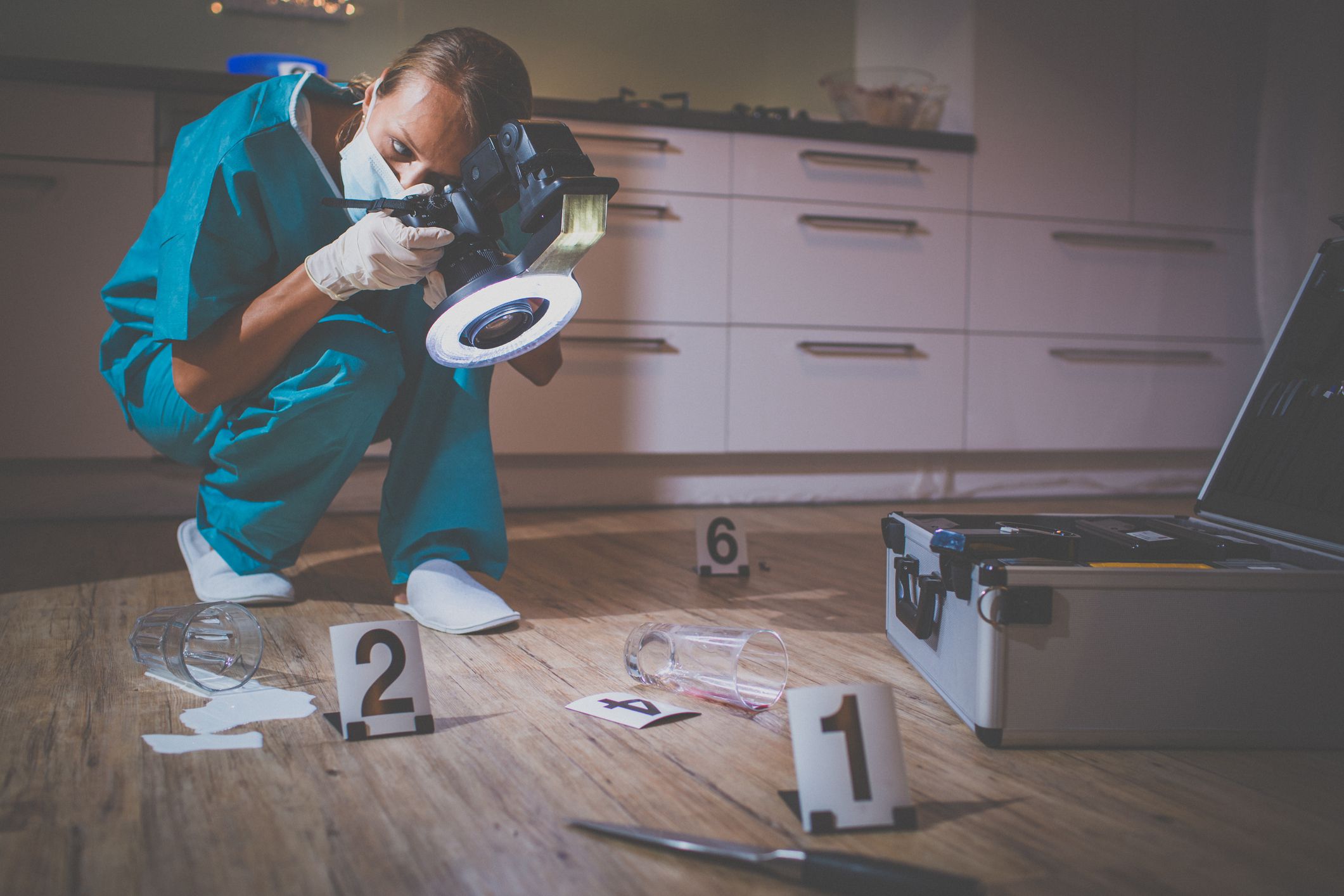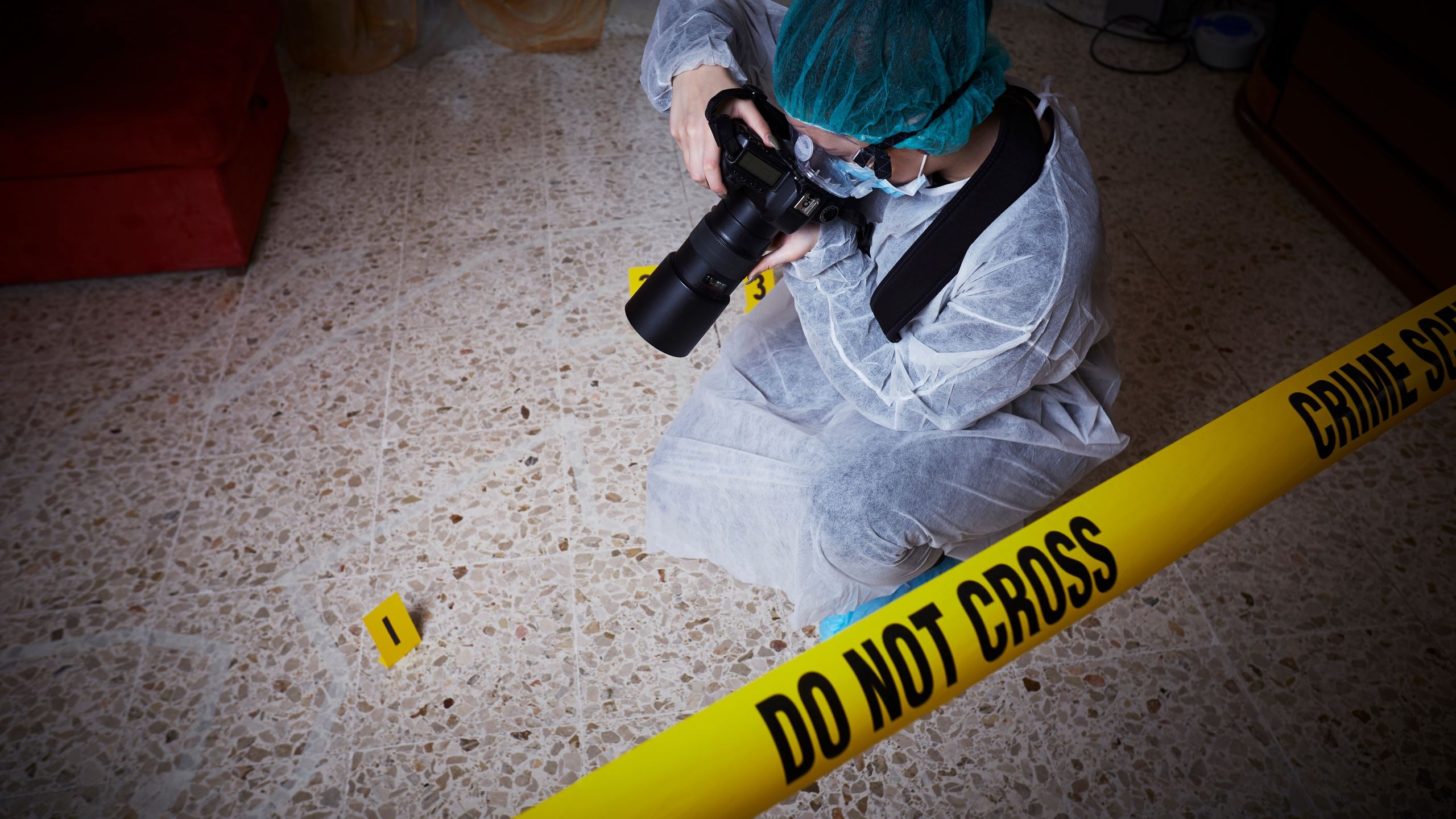The photographer in yellow.

I've always been a fan of mysteries, whether they're books, movies or TV series. Stories that investigate a mystery or a heinous crime fascinate me.
As a photography enthusiast, I have always found all the work done by the Scientific Police particularly intriguing, which in the USA has provided a great deal of material to make highly successful series such as CSI ( Crime Scene Investigation ), in all its various forms.
Now, when – in reality as in cinematic fiction – a body is discovered, the first thing one does, you know, is take a lot of photographs.
There are specialized photographers in this sector, because it is necessary to have specific skills, which – I have told myself several times – would also be useful to the normal photographer, in short, to you and me too, so to speak.
For example, grazing lighting .
If you need to highlight a shoe print imprinted in the mud, or detect a fingerprint that the offender on duty (rather distracted) has left on some surface, you must necessarily resort to a flash light shot grazing the subject himself , with an angle close at 20-30°.
In fact it is a technique that is valid whenever you need to show something that would otherwise go unnoticed.
A good " Forensic Photographer " must know how to manage reflections, for example those on fresh blood (perhaps using a polarizing filter) and above all he must be really good at not deforming the subject with wrong camera angles.
The ideal is to shoot subjects with a "zenithal" shot, ie on the exact vertical ( it is no coincidence that today drones are often used.).
It is also the realm of lenses with little or no distortion, preferably macro.
Now, in films, to tell the truth, they rarely respect these rules (and many others) and those who know about photography pay attention to them.
At the time I had bought the DVDs of the CSI Las Vegas series (I don't like watching television, too many commercials... I know it was said by those who deal with advertising, it's almost blasphemous... but too much cripples) and I remember well that, when digital cameras were introduced around 2004, the actors handled Olympus cameras: at the time they were still very slow and therefore in reality it would have been impossible to shoot in bursts as you see done in TV films since you need to save the files in RAW (or at most in TIF, however the recording of the file was very long).
In the following seasons they switched to Nikons, sometimes with incongruous zoom lenses for truly professional use in this field.

However, a true CSI photographer would work much more calmly and precisely, no doubt resorting – whenever possible – to a tripod, inserting rulers and millimeter squares to show the dimensions of individual details, and so on.
It is (for photographers) a fascinating field, in which creativity must be held in check , but in which technical competence must reach very high levels. If you get it wrong, you run the risk of jeopardizing an investigation.
According to Locard's principle , everything present at the scene of a crime leads to the perpetrator, and the perpetrator certainly carries something of that scene with him. Maybe very small things, but the skill of the person conducting the investigation is to identify them anyway.
The forensic analysis of images has an ancient history, which reaches as far back as the dawn of photography: already in 1851 Marcus A. Root gave life to the first documented example of " forensic authentication ": using a microscope, in fact, he discovered that the coloring process of images developed by the rev. Levi Hill was actually created by hand coloring and not the result of real progress in photography.
But the first to codify the methodologies of this singular field of our beloved art was, at the beginning of the 20th century, Alphonse Bertillon who recommended placing the camera (at the time a cumbersome large-format optical bench) vertically on the scene to be filmed ( zenithal view) together with precise metric and scale indications. To meet this need, a two-meter-high tripod was used. In short, a long and complex work.
Another "author" of forensic photography was the Swiss Rodolphe Archibald Reiss (1875-1929), who in 1903 published a real manual for this type of shooting (" La photographie judiciare ") - In 1909 Reiss also founded the first program of forensic studies at the University of Lausanne.

Now, it doesn't take much to understand that the arrival of digital photography has brought about a real revolution in this field.
In fact, if photo manipulations have always been done, and after all sometimes it is enough just to frame the negative to eliminate a detail, certainly with the arrival of post-production software this matter has become darned easy and above all perfect. To such an extent that it is not at all easy to understand if and how much a photo has been manipulated. How many times have we eliminated small details from our photos, perhaps a stain due to lint or a speck of dust on the sensor?
If done with a minimum of care, it is almost impossible to understand where and how this removal was done. And it is for this reason that the RAW raw format is preferred in the forensic field, which is generally not manipulable.
However, if we are dealing with photographs taken by others (for example a potential witness or even the culprit of a crime) – and therefore most often in Jpeg SOOC ( Straight Out of Camera ) – who tells us that that photo has not been skilfully altered?
And here the so-called " Camera Ballistic " is triggered, the ballistics of the camera, really treated as if it were a weapon. Anyone who has seen at least one thriller film knows the importance of finding a bullet at the scene of a crime: from the scratches on it, it is possible to trace the gun that fired it. The same can be done with a jpeg file, for example, which performs the same function as the bullet.
A photographic sensor, due to the inhomogeneity of the silicon of which it is made, leaves a characteristic imprint on the photograph: normally imperceptible, but detectable with instrumental methods such as the PRNU ( Photo Response Non Uniformity ) which analyzes the noise present in each digital image.
The advantage of this type of analysis is that the sensor "pattern" cannot be altered with digital software and therefore remains stable. Then there are some features that each camera has in an exclusive way, a kind of "fingerprint". In fact, however standardized industrial production may be, there will always be small differences between one model and another, and even between specimens of the same model.

Furthermore, as we know, the photo files have various elements "attached" to them, starting with the EXIF data which shows the characteristics of the camera, the optics used and much more.
It is true that they can be easily deleted, but if you are not very experienced, you may forget to do it. In addition to EXIF, there are other metadata that can be used, such as the IMM ( Information Interchange Model ) also called " IPTC headers " or the better known XMP ( Extensible Metadata Platform ), which are created by Adobe software when a photo is processed .
But you can also examine the thumbnails , and this is a pretty good test. When we take a RAW photo, but in some models also in TIF or Jpeg files, a small photo is created which is used for quick viewing of the photo on the camera display. Therefore, even when the main photo is manipulated, the small attached file remains unchanged. By making a comparison, it's easy to find out the trick.
If all this doesn't work, well , then you need to go and study the photo thanks to very powerful software, which really breaks it down into individual elements.
However, there is a simpler exam, within reach – at least in the simplified version – of anyone: the ELA ( Error Level Analysis ), or JPEG Ghost. It is a method that allows you to highlight areas of the image that have been compressed in a different way.
The basic idea is that the compression of a digital "patch" (piece) placed on an element of the photo to hide it, will be different from that of the rest of the image. So doing an extreme compression of the JPEG this difference could be highlighted, as the two areas have a different "compression noise". Obviously it doesn't always work, but sometimes it can give us the answer we are looking for: was the photo taken by our friend manipulated? With ELA we could (perhaps) find out!
Well, I hope that with this simple information, you are able to more easily understand whether the movie or series you are watching is well done or not. If the photographer takes a bit at random, with a simple zoom lens, and indeed: if it's not a technician who takes the photos, but the policeman himself, change the film or series! Forensic photography is a difficult and delicate art, it certainly cannot be improvised!
When you subscribe to the blog, we will send you an e-mail when there are new updates on the site so you wouldn't miss them.
By accepting you will be accessing a service provided by a third-party external to https://www.insightadv.it/


































































Comments